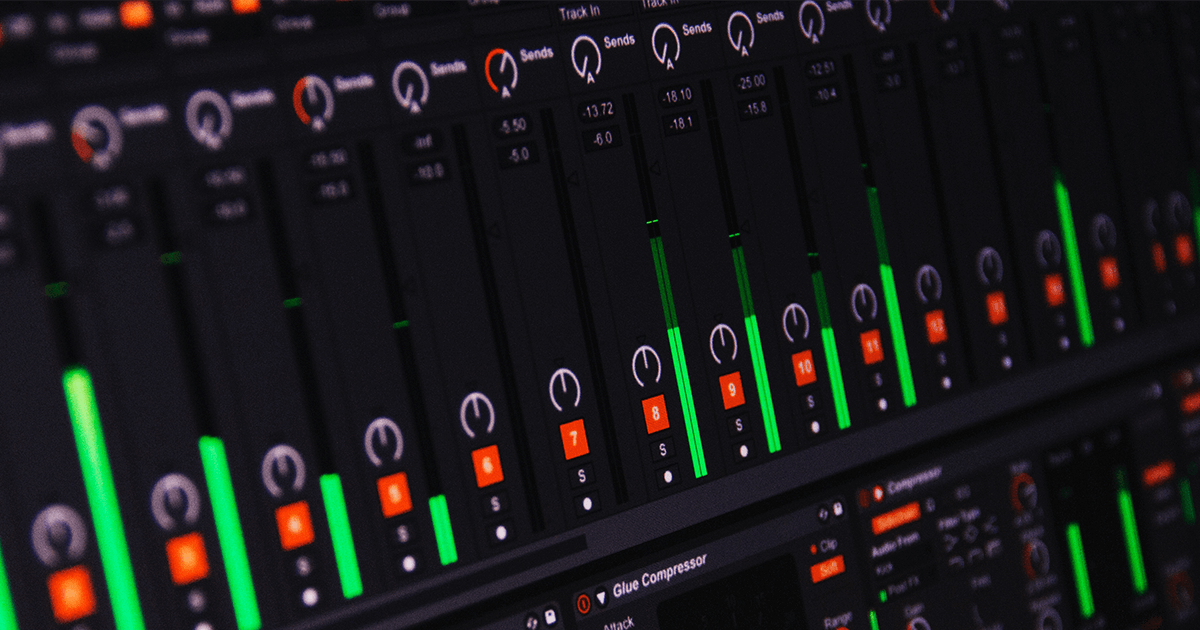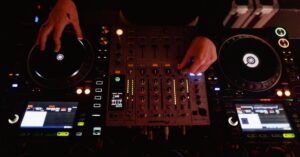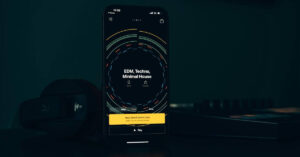Ableton

Market leader for good reason. Huge community and a lot of online resources tailored towards techno available.
FL Studio
Very intuitive user interface. Excellent sequencer and piano roll. Lifetime free updates.
Bitwig

A less pricey Ableton derivative with extensive modulation capabilities and clever workflow enhancements.
What is a DAW?
Digital Audio Workstations (DAWs) are the cornerstone of modern music production. If you’re new to music production, you may have heard the term “DAW” thrown around a lot, but what exactly is a DAW? A Digital Audio Workstation (DAW) is a software application that allows you to record, edit, and produce digital audio. DAWs have become the standard tool for modern electronic music production, and are essential for creating professional-quality recordings. With a DAW, you can record audio, edit and arrange your recordings, and add virtual instruments and effects to create a fully produced song. A DAW typically consists of a graphical user interface (GUI) oriented on classic analog hardware mixers like you would find in high-class studios back in the day. It also includes a range of tools and features that allow you to manipulate and edit your recordings. DAWs have revolutionized the music industry by making it easier and more accessible than ever before for musicians and producers to create professional-quality recordings. Let’s take a closer look at some of the basic components of a DAW:
- Tracks: A track is a container for your audio recordings. You can think of a track as a virtual tape recorder, where you can record and edit audio clips. In most DAWs, you can create multiple tracks, each with its own audio source. Unlike actual tape recorders, the amount of digital tracks is (theoretically) limitless. Practically the CPU power of the computer defines the limit. The more powerful the CPU, the greater the number of digital tracks that can be handled.
- Timeline: The timeline displays the arrangement of your tracks, showing the duration and position of each clip. Also referred to as arrangement view. You can edit the timeline to move, resize, and copy audio clips, allowing you to create complex arrangements as well as automations over the course of time.
- Mixer: The mixer is the control center of your DAW, allowing you to adjust the volume, pan, and effects of each track. With a mixer, you can balance the levels of your tracks individually and create a cohesive mix.
- Virtual instruments and effects: A DAW also includes a range of virtual instruments and effects, which allow you to create a wide range of sounds and textures. Virtual instruments include synthesizers, drum machines, and samplers, while effects include reverb, delay, and distortion. This is what makes DAWs so strong, turning them into full instruments capable of creating complete songs and productions.
There are many different DAWs available on the market, each with its own unique set of features and workflows. Some popular DAWs used in techno music production include Ableton Live, FL Studio, and Logic Pro X. Each of these DAWs offers a range of tools and features, and choosing the right one for your needs can be a daunting task. In the next section, we’ll cover some of the factors you should consider when choosing a DAW for your techno music production needs.
Choosing the right DAW
Choosing the right digital audio workstation for techno production is an important decision, as it will affect your workflow, creativity, and to a certain extent the final sound of your techno tracks. With so many DAWs on the market, it can be overwhelming to know where to start. Here are some factors to consider when choosing a music production software for your techno production needs:
- Workflow: The workflow of a DAW refers to how you interact with the software to create your music and should be an essential criterion for choosing the DAW. Some DAWs are designed for a linear, track-based workflow, while others are more geared towards live performance and improvisation, focussing on a loop-based workflow. Consider the way you like to work and choose a DAW that matches your workflow preferences
- Features: Although all DAWs offer roughly the same set of functions, they differ in the workflow of how these features are implemented. Consider the features that are most important to your techno music production needs, and choose a DAW that handles the task the best. As Techno heavily relies on loops and modulation, DAWs that prioritize these aspects are a better fit. We’ll delve deeper into this topic later on.
- Learning curve and resources: The point is significant as learning a DAW can be a time-consuming and challenging process. Therefore, the availability of free resources can play a crucial role in the decision-making process.. Some DAWs have a steeper learning curve than others. If you’re a beginner to techno music production and you want to achieve results as fast as possible, maybe considering a DAW that has a more intuitive interface is the way to go.
- Budget: DAWs can range in price from free to several thousand dollars. While money certainly plays a significant role, the price factor should not be given too much weight in the decision-making process. Ultimately, it’s the workflow and productivity that one can achieve with the program that matters most. The DAW is a producer’s tool or instrument, and it (hopefully) creates a long-term value that is priceless. Therefore, the price should be considered secondary. Moreover, most programs offer a trial period, which allows you to test them without any obligation, and you should definitely take advantage of this before making a decision.
Best DAWs for producing techno
Since, as mentioned earlier, workflow plays a crucial role in selecting a DAW, I believe that three DAWs are particularly well-suited for producing techno due to their features and workflow nature: Ableton, FL Studio, and Bitwig.
Ableton Live
Ableton Live is one of the most popular DAWs among techno music producers, and for good reason. It was created by Robert Henke and Gerhat Behles (Monolake) in early 2000 1, with a focus on live performance and loop-based improvisation. Given its roots in the electronic music scene, it’s hardly surprising that this program has emerged as as the undisputed industry standard daw for electronic dance music.
One reason why Ableton Live is well-suited for producing techno is its unique Session View. This view allows for non-linear production, where different parts of a track can be triggered and manipulated in real time. This implies that while other DAWs focus on arranging full tracks from the start, Ableton can be used to generate rough sketches from which you can later build entire songs using the arrangement view. This also expands your options later on if you want to perform live at some point, which is easier to accomplish with Ableton Live than with any other music production software. Also, Ableton’s built-in instruments and effects, including the by Robert Henke developed flagship synth, Operator, have also established a reputation for themselves and are still used by many professional producers to this day. On top of that, Ableton is so popular in the techno community due to its unique capabilities with the integration of Max for Live. Max for Live is a feature of Ableton that allows users to create custom instruments, effects, and devices using the Max programming language. Max for Live opens up a world of possibilities for producers, as it enables them to design their own tools that can shape their sound in new and creative ways. Like for example nifty step sequencers, which are essential for Techno.
One of the most significant advantages of Max for Live is the ‘modular approach’ which enables users to create more complex routings and modulations throughout the software.
FL Studio
FL Studio, formerly known as FruityLoops, was first released in 1997 by Belgian company Image-Line. The original version of the software was a simple MIDI drum sequencer that was designed for creating drum loops. Over the years, FL Studio has evolved and expanded to become a full-featured digital audio workstation that offers all fundamental features for producing a track from start to finish. Even though FL Studio has primarily become a favorite among hip-hop and edm producers, it is also used by techno producers nowadays (like for example Rene Wise or Decoder). The workflow in FL Studio is focused on step sequencing and pattern-based composition, which makes it very user-friendly and an ideal choice for techno producers who prefer a more structured approach to composition. The step sequencer in FL Studio is highly intuitive and easy to use, allowing producers to quickly create intricate patterns that can be layered and combined to create complex arrangements. Additionally, FL Studio also offers a variety of built-in instruments, including its flagship synth, Harmor it’s drum machine, FPC, as well as a versatile automation workflow that can be used to automate almost any parameter in the software.
Bitwig
Bitwig Studio is a relatively new DAW that has been gaining popularity among techno producers in recent years. It was released in 2014 and was created by former developers of Ableton Live, which explains why the software has some similarities with Ableton Live. However, Bitwig has some unique features that make it a perfect fit for techno producers.
One of the key benefits of Bitwig Studio over Ableton Live and FL Studio is its modular approach. The modulation system in Bitwig Studio is highly flexible and allows users to modulate virtually any parameter within the DAW. Modulation sources can be assigned to modulation targets through a simple drag-and-drop interface. This allows users to easily set up modulation routings and experiment with different combinations of sources and targets.There are numerous sources of modulation available in Bitwig Studio, including envelopes, LFOs and even audio signals. Bitwig also features ’The Grid’ which is a modular sound design environment and basically a modular Synth within Bitwig Studio, that allows users to create and manipulate sound using a visual, modular interface. It allows users to build custom synthesizers, effects, and other audio processing tools by connecting various modules together in a virtual patch bay. It features a wide range of modules, including oscillators, filters, envelopes, sequencers, and effects. Users can drag and drop modules onto the Grid canvas and connect them using virtual cables. This allows users to create complex and evolving sounds straight out of the box without any additional plugins or hardware.
Finally, Bitwig Studio’s pricing is more affordable than Ableton Live’s. This makes it a great option for techno producers who are just starting out and may not have a large budget for software. Overall, Bitwig Studio’s modular approach, flexibility, hardware integration, and affordable pricing make it a perfect fit for techno producers. If you are a techno producer looking for a DAW that provides endless possibilities for sound design and customization, Bitwig Studio is definitely worth considering.
Getting started with learning DAWs
Learning any new DAW can be overwhelming, but with the right approach, it can also be a rewarding and enjoyable experience. Here are some tips to help you get started with learning your DAW of choice:
- Start with the basics: Before diving into advanced features, it’s important to get a solid grasp of the basics. This includes understanding the interface, navigation, and terminology used in your DAW. Most DAWs come with built-in tutorials or help guides, which can be a great place to start. Also, read the fucking manual. Many DAWs have hidden features or advanced capabilities that are not immediately apparent, and the manual can help users uncover these features and take full advantage of them. Even experienced users can find hidden gems or useful tips that they were not previously aware of by reading the manual.
- Experiment with the different features: Once you have a basic understanding of your DAW, start experimenting with different features and tools. For example, explore and learn every single effect and instrument in the DAW. You need to know all the tools at your disposal before you can start to translate your creative ideas into structured actions.
- Take advantage of tutorials and online resources: There are many tutorials and online resources available that can help you learn your DAW of choice. Especially masterclasses and ‘how to’ videos are tremendously helpful and save you a lot of trial and error.
- Start with simple projects: When starting out with a new DAW, it’s important to start step by step. This will allow you to focus on learning the basics and building your skills, without becoming overwhelmed by complex projects. For example, splitting the production process and focusing on one element at a time.
- practice practice practice: When it comes to learning a DAW, there is no substitute for practice. The process of learning a DAW is never truly complete. This is why it’s important to approach DAW practice as a lifelong journey, rather than a one-time task to be completed. Music production in general is a creative process. While technical skills and knowledge are important, they are only part of the equation. To create compelling music, users must be able to translate their creative vision into reality. This requires a deep familiarity with the software and its capabilities, which can only be achieved through practice.
Conclusion
When it comes to selecting a DAW, the decision is not a matter of right or wrong. With a multitude of DAWs available, each capable of producing techno music, we have narrowed down the options to the three most popular DAWs for techno. These music production softwares have proven to be the most effective for the majority of producers’ workflows. Ultimately, the decision lies with the individual as it is a matter of personal preference. If you, for example, are already achieving good results with Logic, Pro Tools or any other DAW, there’s no need in switching DAWs. In my opinion, your individual needs and preferences should determine your choice of DAW. Thus, it’s important to be clear on what matters most to you. Are online resources crucial to you? Do you require an intuitive workflow that delivers quick results? Do you value advanced modulation and sound design features? Will you perform live in the future? Does budget play a role? Prior to making a decision, asking yourself these questions is vital. Remember, there is no wrong choice. The best DAW for producing techno is ultimately ultimately the one you feel most comfortable with.
The digital audio workstation is the backbone of a producer’s career and essentially their instrument. It is essential to master the DAW inside out, which, like learning to play an instrument, requires a lot of practice and time. Therefore, testing different DAWs before settling on one may be advisable. However, with the three DAWs presented here, you can’t go wrong!







